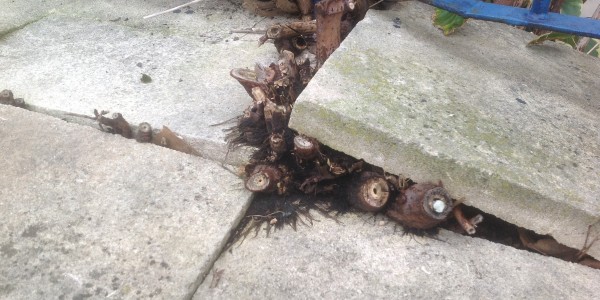
Japanese knotweed – or Fallopia japonica to give it its proper name – is a real pest of a plant that’s taken root on properties all across the UK.
So, what do you do if you’re a homeowner and have this shrub growing in or near your home?
Will insurers cover you for any damage caused to your property by Japanese knotweed?
And how do you get rid of the invasive species if you’re unlucky enough to discover it growing in your garden or near your property?
How to identify Japanese knotweed

TP Knotweed Solutions
Japanese knotweed is a tall, leafy plant that sprouts up in spring and dies back every winter, leaving an unattractive mass of dead canes.
It has thick, bamboo-like stems, distinctive heart-shaped leaves arranged in a zig-zag pattern along the stalk, and white sprays of flowers in summer.
It grows at speeds of up to a metre a month, swamping native plant species and pushing out associated wildlife. The dense thickets it creates can be several metres thick and up to three metres high.
Beneath ground, the roots of Japanese knotweed can penetrate up to three metres deep and seven metres across.
It’s these roots, and the shoots that come from the rhizomes (subterranean stems) at the crown, which cause such destruction.
They’re incredibly strong – they can break through tarmac and concrete – and just a tiny section of root, rhizome or stem that’s been irresponsibly disposed of can be all it takes for a new plant to grow.
Pieces of rhizome or stem can be spread by fly-tipping or carried by waterways, especially after heavy rains or flooding.
It’s one of the reasons clumps of Japanese knotweed are often found on riverbanks, roadsides and wasteland.
Where does Japanese knotweed come from?
Japanese knotweed is not native to the UK – it’s an ‘invasive alien’ species.
As the name suggests, the plant originates from Japan. It was brought over in the late 1840s as an exotic specimen for UK botanical gardens before being sold to Victorian gardeners as an attractive and decorative shrub.
In the volcanic soil of its native Japanese homeland, the climate and regular deposits of ash plus the insects and fungi that fed on the shrub had kept knotweed plants small.
But in Britain there were no natural blockers. Gardeners trying to get rid of the monster plant in waste and compost may have inadvertently spread it further by distributing tiny sections of regenerative vegetation.
In 1981 the Wildlife and Country Act made it an offence to introduce the plant into the wild.
Today, you could be fined up to £5,000 or be sent to prison for up to two years if you allow contaminated soil or plant material from any waste you transfer to spread into the wild.
Why is Japanese Knotweed so hard to remove?

TP Knotweed Solutions
Unsurprisingly, because Japanese knotweed is so resilient and prolific, it’s very hard to get rid of. This makes removing it very expensive.
It's a fast-growing invasive plant and can grow at speeds of 10cm a day in summer.
If left untreated, these emerging shoots can quickly exploit weaknesses in brick, tarmac, and metal piping, causing costly damage to everything from buildings to roads.
The underground rhizome network can spread 7m across and 3m down, making it very difficult to get rid the plant unless you know how to treat it effectively.
Under environmental protection laws, waste containing knotweed must be treated and disposed of by an accredited contractor – so disposal is not something the average homeowner can tackle by themselves.

TP Knotweed Solutions
Any Japanese knotweed-contaminated soil or plant material you need to dispose of is likely to be classified as 'controlled waste' under The Environmental Protection Act 1990.
They'll need to either be burned on site or taken to a licensed landfill via a knotweed specialist who holds a Waste Carriers License from the Environment Agency.
Treatment programmes are expensive and can take up to three years. And there’s potential for re-growth as the plant can lie dormant for up to 20 years.
Removal treatments for Japanese knotweed include:
- Chemicals – potent herbicides are sprayed onto and/or injected into the plant by a certified professional over a number of years.
- Burial – plants are buried at a depth of at least 5m and covered or wrapped with a root barrier membrane.
- Burning – the crown and rhizomes may survive burning so they still need to be disposed of using another method.
Mortgages and Japanese knotweed
Because of the structural damage Japanese knotweed can do to buildings and the costs associated with removal, mortgage lenders have typically been unwilling to invest in properties affected by it.
A property with a knotweed problem or with knotweed nearby does not offer good security for a mortgage investment as it may lose value if the knotweed becomes an infestation.
Some mortgage providers will decline an application if there’s Japanese knotweed in a neighbouring garden – or even several gardens away.
Other mortgage lenders will hold back part of the money until you’ve signed a legally binding contract to eradicate the problem.
TP Knotweed Solutions’ Tom Payne says: “There’s no denying Japanese Knotweed is a very attractive plant in the summer, but we need to look at the wider issues and the negative impact on your home and investment should it be present in your garden.
“When selling a property, you'll be faced with a question in the Law Society’s TA6 Property Information Form ‘Is the property affected by Japanese knotweed? If yes, you then need to state whether there is a Japanese Knotweed management plan in place and supply a copy."
“Without a herbicide treatment programme in place, with a 10-year insurance backed guarantee, the majority of mortgage lenders will refuse to lend. The value of the property will also be significantly reduced if not given a nil value, until a programme by an accredited specialist is in place.”

Does Japanese knotweed affect home insurance?
Having Japanese Knotweed doesn’t necessarily mean you can’t get home insurance. Your insurer will typically want to look at a few things before covering you:
- How long has Japanese Knotweed been present?
- Is it in your property or a neighbour’s property?
- How far is the knotweed from the house, outbuildings and drains?
- Is it being professionally controlled? Since when, and when is it expected to be eradicated?
- Has it caused any damage to the property now or in the past?
Most insurers, including Admiral, won't cover your home if Japanese knotweed damage has already occurred. You may get cover for subsidence caused by knotweed if you already have a comprehensive buildings insurance policy in place.
Most insurers will not cover the treatment or removal of the plant, the cost of which can run into tens of thousands of pounds.
You're required to do everything you can to prevent any damage to your property. You may also be liable if you allow knotweed to infest neighbouring properties.
Both mortgage lenders and insurers may ask you if you have Japanese knotweed on or near your property before they quote.
The best thing to do is be completely honest to make sure you have the right cover in place and that you're not left without cover should you ever need to make a claim.


